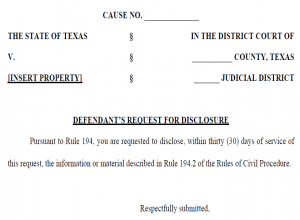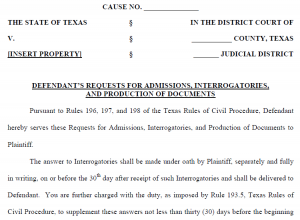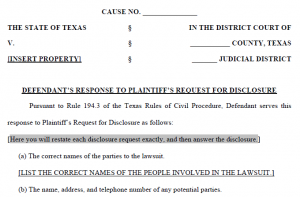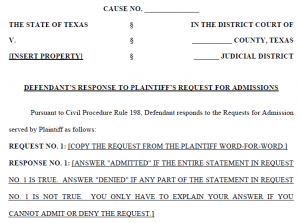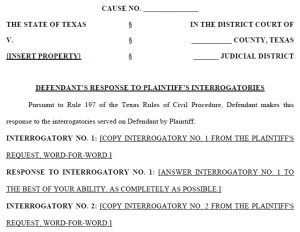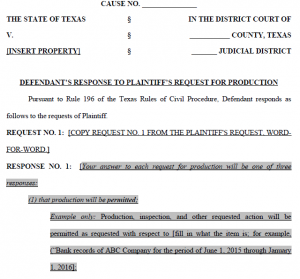Before a case goes to trial, both parties can participate in a process called discovery. The purpose of discovery is to allow both you and the State to learn about all the issues and facts of the case, and to prevent both of you from being surprised during trial. Discovery can also result in the case being resolved without going to trial. For example, a party may make a request to the court for summary judgment at the end of discovery.
You can get discovery from the State about anything that has to do with your case. The State can also obtain discovery from you about anything that has to do with the case.
Both you and the State have to follow certain rules when sending and answering discovery requests. The discovery rules are found in the Texas Rules of Civil Procedure. If you do not try to follow those rules, you could be subject to sanctions, which are penalties that the court can impose. The court can impose several different types of sanctions. For example, if you do not respond to the State’s discovery requests and the State requests that the court impose sanctions, the court could order you to pay money to the State or order you to do community service. The State can also receive sanctions if it does not follow the discovery rules and it could also be ordered to, for example, pay you money.
Types of Discovery
There are seven types of discovery:
- Requests for disclosure;
- Requests for production and inspection of documents and tangible things ("requests for production");
- Requests for motions for entry upon and examination of real property;
- Interrogatories to a party;
- Requests for admission;
- Oral or written depositions; and
- Motions for mental or physical examinations.
The types of discovery most commonly used in asset forfeiture cases are requests for disclosure, requests for production, interrogatories, and requests for admission. This section of the Toolkit provides a description of these four types of discovery and provides sample forms to use when sending discovery requests to the State and responding to discovery requests from the State. The example discovery forms may prove useful in discovery for an asset forfeiture case.
Please note: Carefully review each discovery form and change the document where needed to fit your specific case. It is impossible to draft an example discovery form in a way that anticipates all possibilities for every case.
Levels of Discovery
Besides the seven types of discovery, there are also three levels of discovery: Level 1, Level 2, and Level 3. The State will choose which level of discovery that will be used for the case – either Level 1 or 2. Most cases occur under Level 2 discovery. Level 3 discovery will only happen if a court specifically orders that discovery be conducted at Level 3.
- Under a Level 1 discovery plan, the discovery period lasts for 180 days from the date of the first request for discovery.
- Under a Level 2 discovery plan, the discovery period ends either (a) thirty days before the date set for the trial; or (b) nine months after the date of the first oral deposition or nine months after the due date of the first response to written discovery, whichever is earlier.
- Under a Level 3 discovery plan, the court will set the end of the discovery period or the deadline for serving discovery.
Requests for Disclosure
A "Requests for Disclosure" must be served no later than 30 days before the end of any discovery period. Different rules will apply, depending on the Level of discovery. (See above on Levels of Discovery.)
Your "Response to Plaintiff’s Request for Disclosure" must be served on the State within 30 days after you receive that Request. However, if the State serves you with a Request For Disclosure before your Answer is due, you do not have to respond to the State’s Request for Disclosure until 50 days after you receive it.
If your answer later changes or if you learn new information that you did not include in your first Response, you will need to update (also known as, "Amend") your Response to Plaintiff’s Requests for Disclosure through the court.
Requests for Production
You can use the form in this Toolkit titled "Defendant’s Requests for Admissions, Interrogatories, and Production of Documents" to request that the State give you any necessary:
- document;
- object; or
- information.
You should file this document if you want to see, sample, photograph, copy, or perform any (nondestructive) test on a document or object that the State has in its possession. You may not serve the State with the Request any later than 30 days before the end of the discovery period. (See above section on Levels of Discovery to find out how long your discovery period is.)
You should use the form in this Toolkit titled "Response to Plaintiff’s Requests for Production" to respond to any Request for Production from the State. Your Response must be served on the State within 30 days after you receive that Request. However, if the State serves you with a Request for Production before your Answer is due, you do not have to respond to the State’s Request for Production until 50 days after you receive it.
Interrogatories
You can use the form in this Toolkit titled "Defendant’s Requests for Admissions, Interrogatories, and Production of Documents" to ask the State to answer your interrogatories or questions. You should use this document to ask about any information relevant to the case (except for information about the State’s testifying experts, if they have any).
Depending on which level discovery the case is proceeding under, different discovery rules may apply. On a Level 1 discovery plan, you or the State can only serve up to 15 interrogatories. On a Level 2 discovery plan, you or the State can only serve up to 25 interrogatories.
Discovery limits do not include interrogatories asking only for identification or authentication of specific documents. Each distinct part of an interrogatory is counted as a separate interrogatory. (For example, if you have Interrogatory 1(a), 1(b), 1(c), and 1(d), that counts as 4 of your allowable interrogatories.) You cannot serve the State with Interrogatories if there are fewer than 30 days left in the Discovery part of the case.
You should use the form in this Toolkit titled "Defendant’s Response to Plaintiff’s Request for Interrogatories" to respond to any Interrogatories from the State. Your Response must be served on the State within 30 days after you receive those Interrogatories. However, if the State serves you with Interrogatories before your Answer is due, you do not have to respond to the State’s Interrogatories until 50 days after you receive it.
Requests for Admissions
You can use the form in this Toolkit titled "Defendant’s Requests for Admissions, Interrogatories, and Production of Documents" to require the State to admit or deny the truth of any matter within the scope of Discovery for the case. This procedure is meant to simplify the issues for trial by eliminating issues that both parties agree. You can use Requests for Admissions to show that there is no dispute for specific statements of opinion or of fact. You cannot serve the State with a Request if there are fewer than 30 days left in the discovery part of the case.
You should use the form in this Toolkit titled "Response to Plaintiff’s Requests for Admission" to respond to any Request for Admission from the State. Your Response must be served on the State within 30 days after you receive that Request. However, if the State serves you with a Request for Admissions before your Answer is due, you do not have to respond to the State’s Request for Admissions until 50 days after you receive it.
Defendant's Request for Disclosure
Defendant's Request for Admissions, Interrogatories, and Production of Documents
Defendant's Response to Plaintiff's Request for Disclosure
Defendant's Response to Plaintiff's Request for Admissions
Defendant's Response to Plaintiff's Interrogatories

